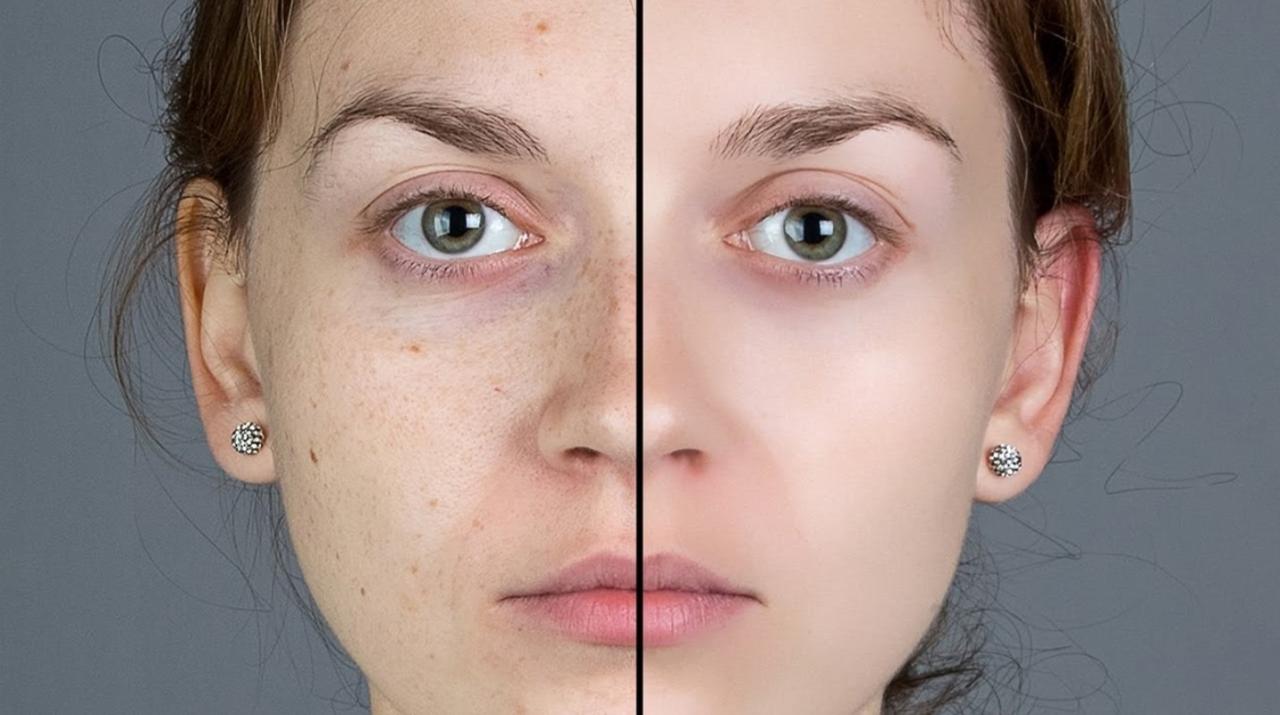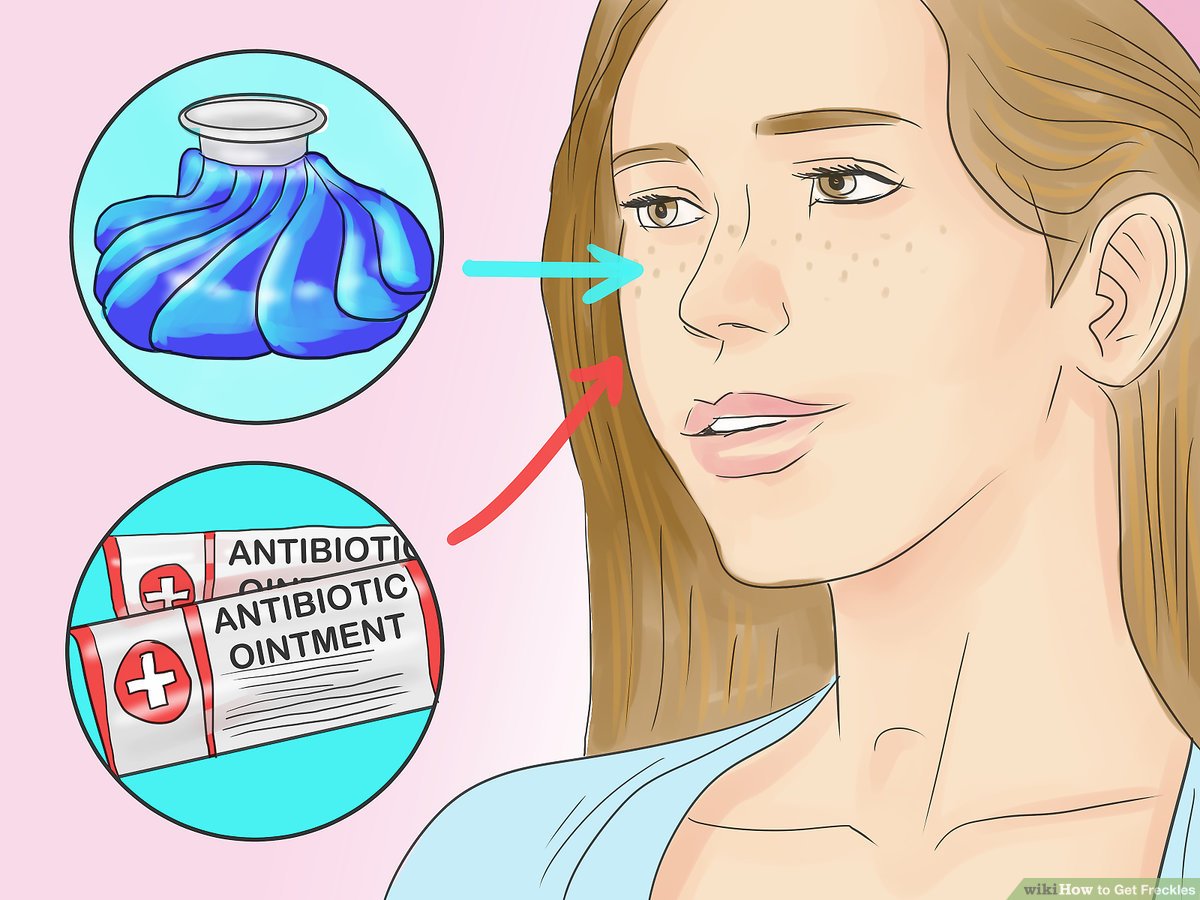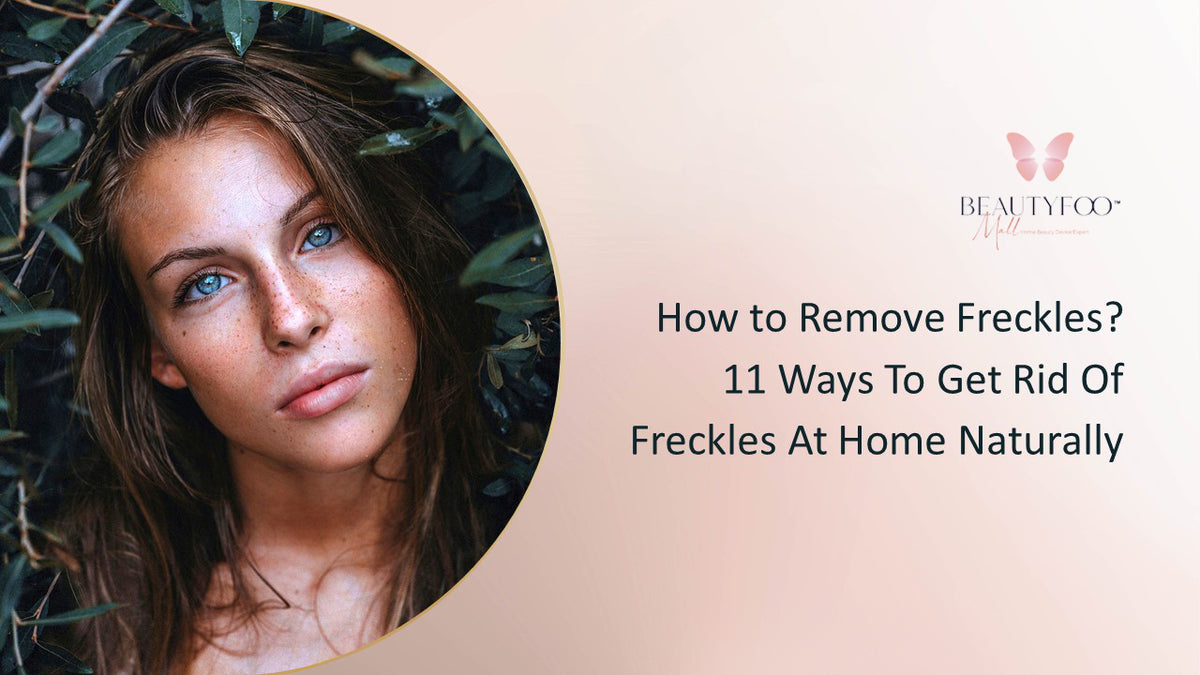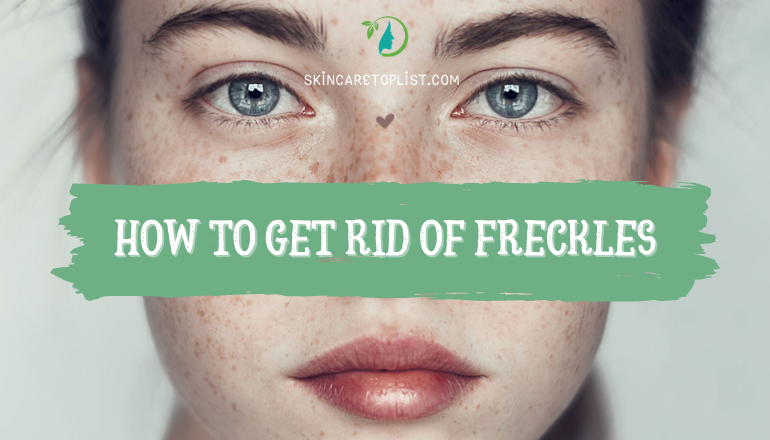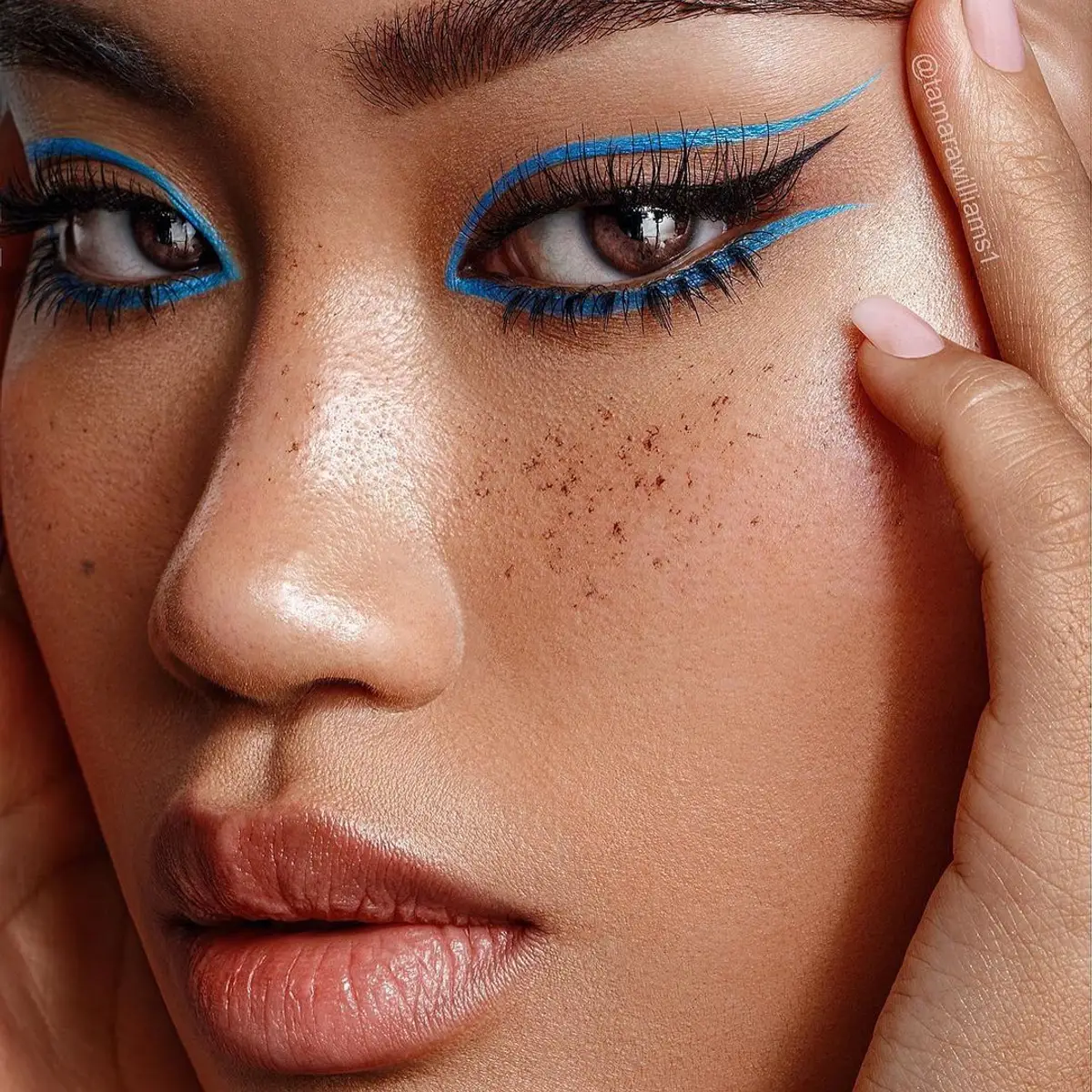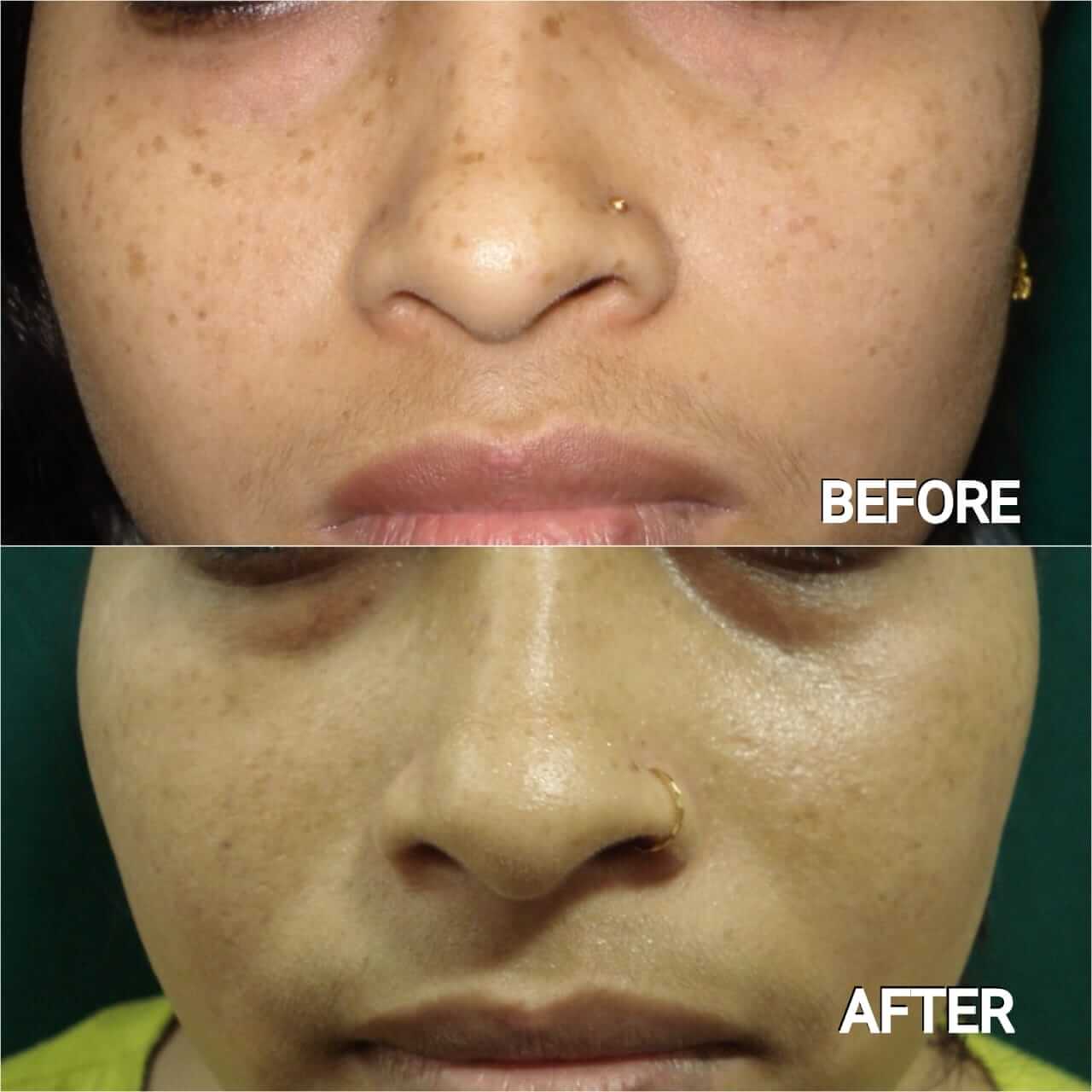Understanding Freckles
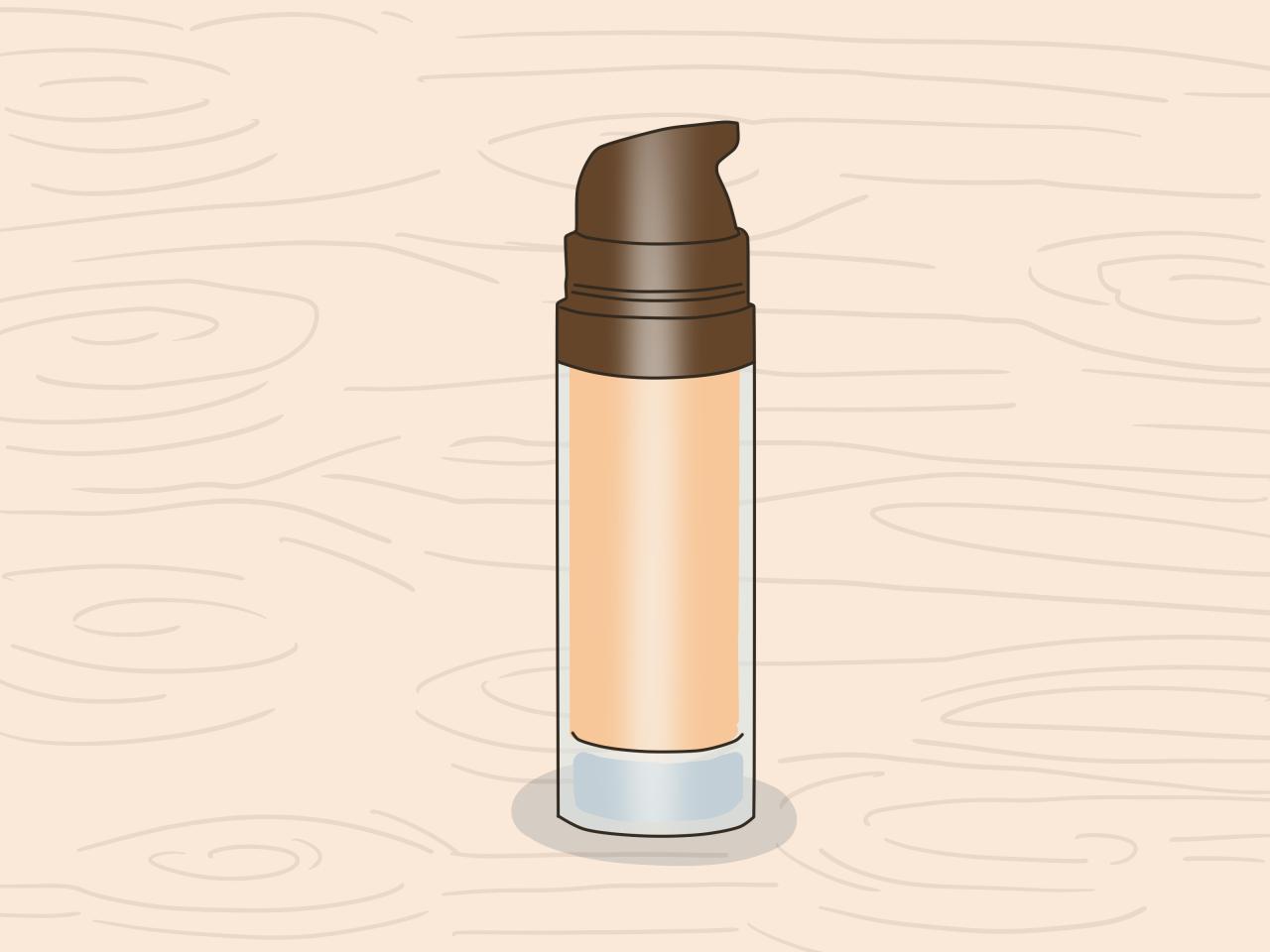
Freckles are common, benign skin marks that appear as small, flat, and often pigmented spots. They are a frequent cosmetic concern, but generally pose no health risk. Understanding their formation and characteristics is key to appreciating their presence and managing any related concerns.
Freckles are typically characterized by their small size, ranging from a few millimeters to about 5 millimeters in diameter. They often appear in clusters, predominantly on sun-exposed areas of the body, such as the face, shoulders, and back. Their pigmentation varies, but is typically light brown or tan.
Formation of Freckles
Freckles develop due to an increase in melanin production in the skin. Melanin is a pigment that protects the skin from the harmful effects of ultraviolet (UV) radiation from the sun. Exposure to UV radiation triggers melanocytes, specialized cells in the skin, to produce more melanin, leading to the appearance of freckles. This process is influenced by both genetic predisposition and environmental factors.
Common Characteristics of Freckles
Freckles typically manifest as small, flat, and pigmented spots. Their color can range from light brown to dark brown, often exhibiting a tan hue. They frequently appear clustered together, particularly on sun-exposed areas. The size of freckles is generally small, commonly less than 5mm in diameter.
Prevalence of Freckles
Freckles are extremely common, affecting individuals with fair to light skin tones. Their prevalence increases with sun exposure and genetic predisposition. While they are usually harmless, some individuals may desire to minimize or eliminate them due to aesthetic reasons.
Types of Freckles and Variations
Freckles can exhibit subtle variations in appearance, but there aren’t distinct clinically recognized types beyond the general characteristics. Individual variations might include differences in color intensity, size, and distribution across the skin. However, the underlying mechanism for their development remains similar.
Freckles vs. Other Skin Marks and Blemishes
Freckles are distinguishable from other skin marks and blemishes. For instance, they differ from moles, which are often larger, darker, and have a different texture. They also differ from age spots, which are typically larger, more irregular in shape, and develop later in life due to sun damage. Recognizing the distinctions is important for proper identification and management.
Genetic and Environmental Factors
Genetics plays a significant role in determining an individual’s susceptibility to freckles. Individuals with lighter skin tones are more prone to developing freckles. Environmental factors, such as sun exposure, also significantly contribute to their appearance. High levels of UV radiation stimulate increased melanin production, resulting in more prominent freckles.
Table of Freckle Types
| Type | Color | Size | Distribution |
|---|---|---|---|
| Common Freckles | Light brown to dark brown, tan | Usually less than 5mm | Clusters on sun-exposed areas |
Methods for Reducing Freckles: How To Eliminate Freckles
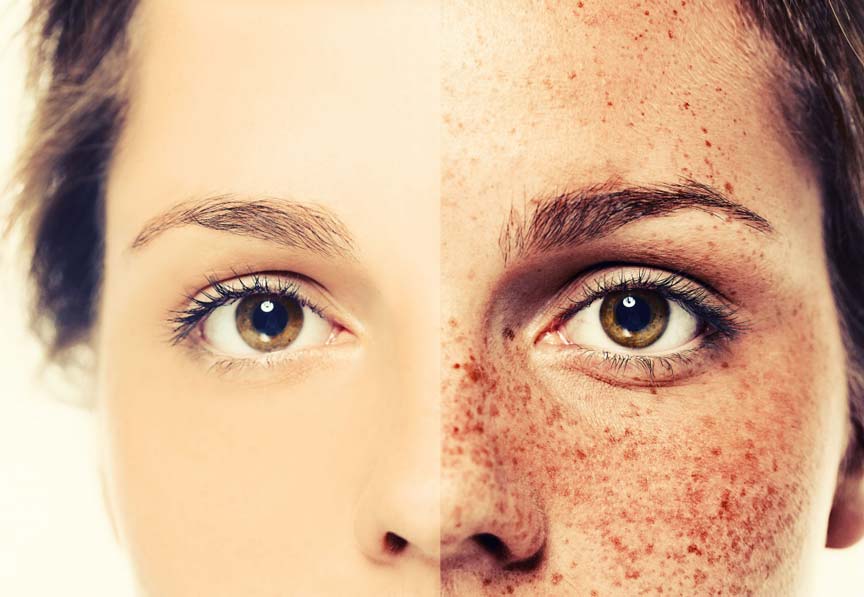
Freckles, those small, often brown or tan spots, are a common skin condition. While generally harmless, many individuals desire to reduce their appearance. Various methods, ranging from topical treatments to lifestyle adjustments, can be employed to achieve this goal. Understanding the effectiveness and potential drawbacks of each approach is crucial for making informed decisions.
Reducing the visibility of freckles often involves a multi-faceted strategy, combining topical treatments with lifestyle choices. The most effective approach is frequently a tailored combination of these methods, taking into account individual skin types and sensitivities.
Topical Treatments for Freckle Reduction
Topical treatments aim to lighten or fade freckles by targeting the melanin production responsible for their coloration. These treatments can range from over-the-counter options to prescription-strength formulas. A crucial consideration is the potential for side effects, such as skin irritation, dryness, or allergic reactions. Consult a dermatologist before initiating any new topical treatment, especially if you have sensitive skin or a history of skin conditions.
Effectiveness and Side Effects of Topical Treatments
Hydroquinone, a common ingredient in many skin lightening products, is known for its ability to inhibit melanin production. However, prolonged use can cause skin irritation and hyperpigmentation (darkening of the skin). Azelaic acid is another effective option that targets bacteria and reduces inflammation, potentially improving skin texture and tone, while also reducing freckles. Kojic acid, derived from mushrooms, is also used to inhibit melanin production. However, its effectiveness can vary from person to person. Retinoids, known for their anti-aging properties, can also help fade freckles. But, they can increase skin sensitivity to sunlight, making sun protection crucial.
Home Remedies for Freckle Reduction
Several home remedies are touted for lightening freckles, including lemon juice, vitamin C serum, and honey. While some individuals report minor improvements, the scientific evidence supporting their effectiveness is limited. The acidity of lemon juice, for example, can cause skin irritation and may not be suitable for all skin types. The potential benefits must be weighed against the potential risks of irritation and skin damage.
Comparison of Skin Lightening Products
Numerous skin lightening products claim to reduce freckles. However, the efficacy and safety of these products can vary significantly. The claims made by different brands should be scrutinized critically. Some products might contain potent ingredients, while others may have minimal impact. The active ingredients and concentrations should be considered carefully.
Comparison Table of Topical Lightening Products, How to eliminate freckles
| Product | Active Ingredients | Application Method | Cost (approximate) | Potential Side Effects |
|---|---|---|---|---|
| Hydroquinone Cream 2% | Hydroquinone | Apply a thin layer to affected areas twice daily | $15-$30 | Skin irritation, hyperpigmentation |
| Azelaic Acid Serum | Azelaic Acid | Apply a thin layer to affected areas once or twice daily | $20-$40 | Mild skin irritation, dryness |
| Kojic Acid Cream | Kojic Acid | Apply a thin layer to affected areas once or twice daily | $15-$25 | Skin irritation, redness |
| Retinol Cream | Retinoids | Apply a thin layer to affected areas once or twice daily | $15-$40 | Increased sun sensitivity, skin dryness, peeling |
Topical Treatments for Freckles
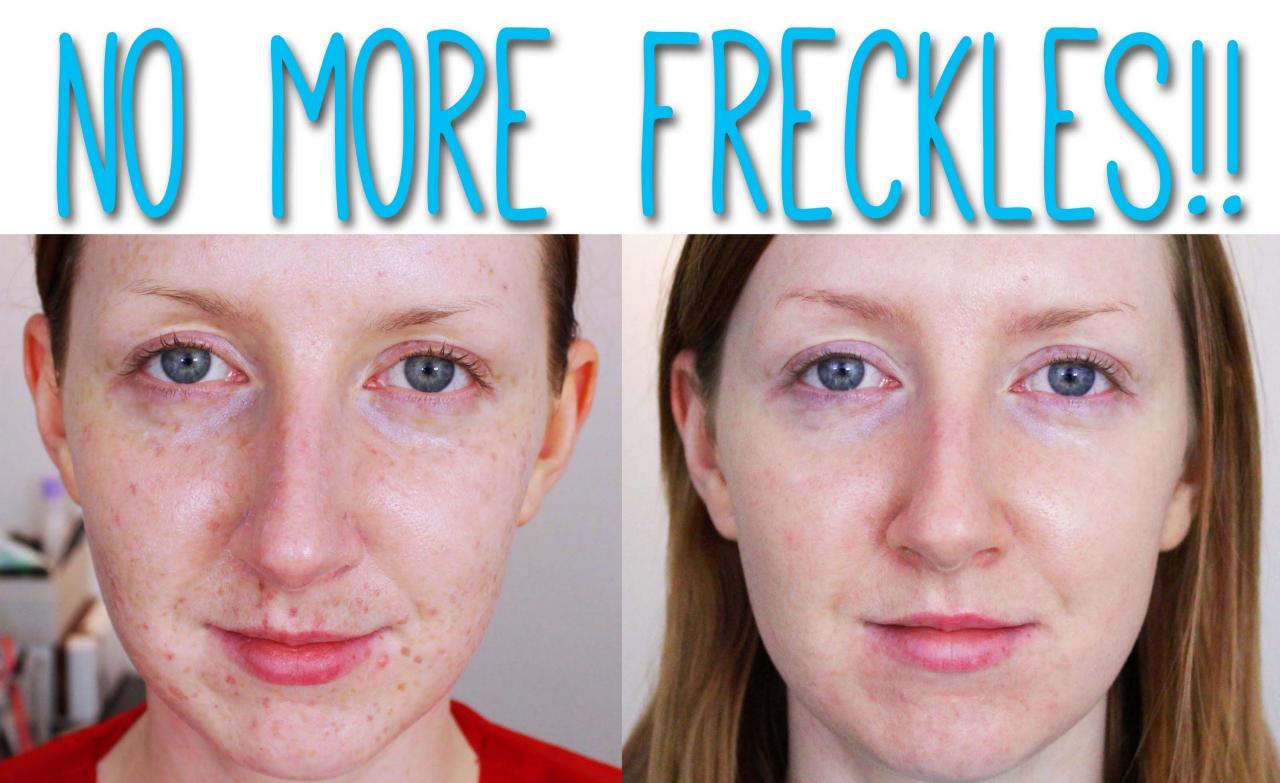
Topical treatments offer a range of approaches to reduce the appearance of freckles. These methods work by targeting the melanin production, the pigment responsible for freckles. By understanding the mechanisms of action and proper application techniques, individuals can potentially lighten or fade freckles, though results may vary.
Chemical peels, retinoids, and hydroquinone are common topical treatments for reducing freckles. These treatments work through different mechanisms, and each comes with its own set of potential benefits and risks. Understanding these distinctions is crucial for making informed decisions about your skin care regimen.
Chemical Peels
Chemical peels employ chemical solutions to exfoliate the skin, removing the top layers that contain freckles. This process can stimulate the production of new skin cells, potentially leading to a reduction in the appearance of freckles. The strength of the peel dictates the depth of skin penetration and the associated recovery time.
- Key Ingredients: A variety of alpha-hydroxy acids (AHAs), beta-hydroxy acids (BHAs), and other chemical exfoliants. Examples include glycolic acid, lactic acid, and salicylic acid. The concentration and combination of these ingredients vary depending on the peel type and intended results.
- Application: Chemical peels are typically applied by a dermatologist or licensed aesthetician. The procedure involves applying the peel solution to the affected area, followed by rinsing and aftercare instructions.
- Potential Risks: Possible side effects include redness, swelling, and mild discomfort. More severe reactions, such as scarring or infection, are less common but possible, especially with stronger peels. It is essential to follow the instructions provided by the professional administering the treatment and to monitor the skin for any unusual reactions. Sensitivity to the specific ingredients can vary between individuals.
Retinoids
Retinoids, often derived from vitamin A, stimulate cell turnover, effectively fading freckles by promoting the production of new skin cells. They can also help prevent the formation of new freckles.
- Key Ingredients: Retinoids such as tretinoin (often prescribed by dermatologists) and retinol (commonly found in over-the-counter products). The strength and concentration vary, and different retinoids may have varying effects.
- Application: Retinoids are typically applied topically to the affected areas, often at night, as they can increase skin sensitivity to sunlight. It is crucial to start with a low concentration and gradually increase it as tolerated. Consistent use over several weeks or months is usually necessary for noticeable results.
- Potential Risks: Retinoids can cause dryness, redness, peeling, and irritation. It’s essential to apply a moisturizer to maintain skin hydration. Sensitivity to sunlight is increased, so using a high SPF sunscreen during the day is crucial.
Hydroquinone
Hydroquinone is a skin-lightening agent that inhibits melanin production, thereby reducing the appearance of freckles.
- Key Ingredients: Hydroquinone. Concentrations vary, with higher concentrations generally showing faster results, but also carrying increased risk.
- Application: Hydroquinone is typically applied topically to the affected area. The recommended application frequency and duration may vary depending on the individual and the product’s concentration. It’s important to follow the product instructions precisely and to use it as directed.
- Potential Risks: Hydroquinone use has been associated with skin irritation, redness, and discoloration. Long-term use may lead to skin sensitivity and uneven skin tone. In some cases, there’s a risk of hyperpigmentation or other skin reactions.
Lifestyle Changes for Reducing Freckle Appearance
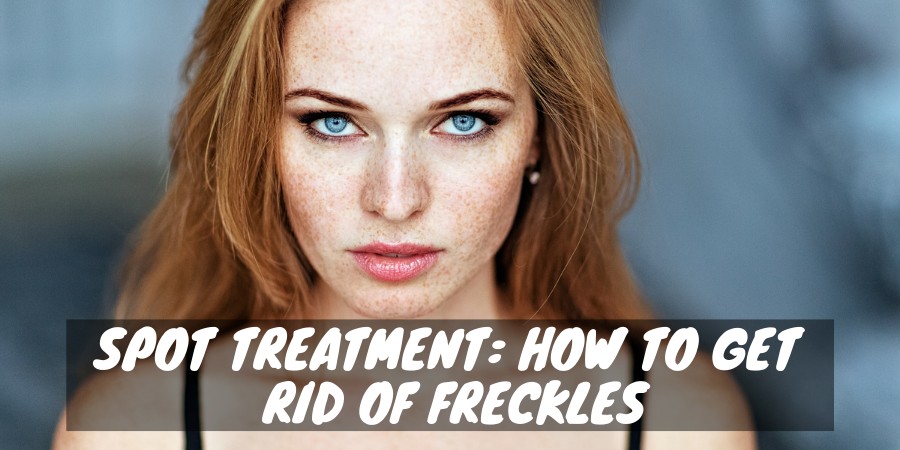
Freckles, those charming little spots, are often a result of sun exposure. While genetics play a role, lifestyle choices can significantly influence their appearance. By adopting specific habits, you can help reduce the appearance of freckles and maintain healthy skin.
A key component in minimizing freckles is understanding how sun exposure affects them and actively working to mitigate its impact. Consistent sun protection is paramount. This encompasses a multifaceted approach, extending beyond just sunscreen application.
Sun Protection Strategies
Effective sun protection is crucial for preventing and reducing the appearance of freckles. Consistent sun protection, including the use of sunscreen, protective clothing, and seeking shade during peak sun hours, can significantly reduce the appearance of freckles.
- Sunscreen Application: Sunscreen acts as a physical barrier, blocking ultraviolet (UV) radiation from reaching the skin. Regular application is essential, especially during peak sun hours (10 a.m. to 4 p.m.). Reapply every two hours, or more frequently if swimming or sweating. A broad-spectrum sunscreen with a Sun Protection Factor (SPF) of 30 or higher is recommended.
- Protective Clothing: Long-sleeved shirts, wide-brimmed hats, and UV-protective sunglasses offer an additional layer of protection against harmful UV rays. These items are particularly important for outdoor activities and can help minimize sun exposure and, consequently, the appearance of freckles.
- Seeking Shade: During peak sun hours, seeking shade is a simple yet effective way to limit sun exposure. Trees, umbrellas, and covered areas provide natural protection from the sun’s rays, which can significantly reduce the risk of developing or worsening freckles.
Role of Sunscreen in Freckle Prevention
Sunscreen is a cornerstone of preventing and reducing the appearance of freckles. It acts as a physical shield, blocking harmful UV rays from reaching the skin. The higher the SPF, the greater the protection.
“A broad-spectrum sunscreen with an SPF of 30 or higher is generally recommended for effective protection against freckles.”
The effectiveness of sunscreen depends on its application. Regular application, reapplication, and appropriate selection are key to maximizing its benefits. This includes choosing a sunscreen suitable for your skin type.
Importance of Healthy Diet and Hydration
A balanced diet rich in antioxidants and vitamins, coupled with adequate hydration, contributes to overall skin health, including the appearance of freckles.
- Antioxidant-Rich Foods: Foods rich in antioxidants, such as fruits and vegetables, can help protect skin cells from damage caused by free radicals, which can contribute to premature aging and the appearance of freckles. Examples include berries, leafy greens, and citrus fruits.
- Hydration: Drinking plenty of water helps maintain skin elasticity and moisture, which can improve skin tone and texture. This can, in turn, contribute to a more even appearance and potentially reduce the visibility of freckles.
Sunscreen Comparison Table
| Sunscreen | SPF | Key Ingredients | Skin Type Suitability |
|---|---|---|---|
| Brand A | 30 | Zinc oxide, titanium dioxide | Sensitive, acne-prone |
| Brand B | 50 | Oxybenzone, octinoxate | Normal to oily |
| Brand C | 45 | Mineral-based | All skin types |
Note: This table is for illustrative purposes only and does not represent a comprehensive list. Always consult with a dermatologist for personalized recommendations.
Preventing Freckle Formation
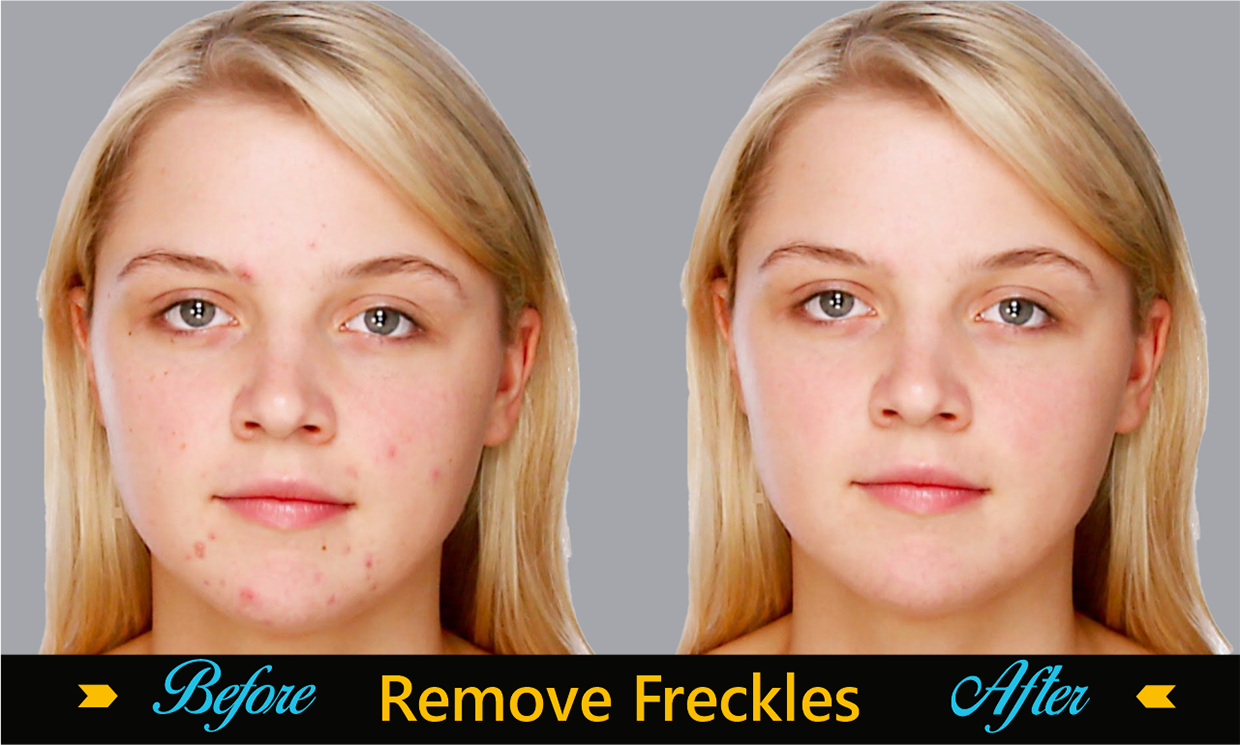
Freckles, those small, brown spots that often appear on sun-exposed skin, are a common skin condition. While generally harmless, many people desire to minimize their appearance or prevent new freckles from forming. Understanding the factors contributing to freckle development is crucial for implementing effective preventative measures.
Preventing the formation of new freckles hinges primarily on protecting the skin from the damaging effects of ultraviolet (UV) radiation from the sun. Genetics also play a significant role in determining an individual’s susceptibility to freckle development. A proactive approach to sun protection and a healthy lifestyle can significantly reduce the likelihood of new freckles emerging.
Sun Protection Measures
Protecting the skin from excessive sun exposure is paramount in preventing new freckle formation. Prolonged and unprotected sun exposure triggers the production of melanin, the pigment responsible for freckles. Consistent sun protection strategies are essential for minimizing this pigment response.
- Sunscreen Application: Employ a broad-spectrum sunscreen with an SPF of 30 or higher. Apply liberally and frequently, particularly during peak sun hours (10 a.m. to 4 p.m.). Reapply every two hours, or immediately after swimming or sweating.
- Protective Clothing: Wear protective clothing, such as long-sleeved shirts, wide-brimmed hats, and UV-protective sunglasses, to shield the skin from direct sunlight.
- Seek Shade: Find shade whenever possible, especially during the most intense sun periods. Utilize umbrellas, trees, or other shaded areas to minimize skin exposure.
- UV-Protective Window Films: Consider using UV-protective window films for car windows and home windows to minimize sun exposure indoors, as sunlight can still penetrate glass.
Genetic Predisposition
Genetics significantly influence an individual’s susceptibility to developing freckles. People with certain genetic variations, often associated with lighter skin tones, are more prone to freckles. Individuals with a family history of freckles are more likely to develop them. While genetics play a role, consistent sun protection remains the most effective strategy for minimizing freckle appearance.
Importance of Regular Skin Checks
Regular self-examinations and professional consultations are vital for detecting any changes in moles or skin spots, including freckles. Skin cancer can sometimes manifest as unusual changes in existing freckles or new spots. Early detection is crucial for successful treatment. Professional dermatological assessments provide a comprehensive evaluation and guidance for appropriate action.
Creating a Daily Sun Protection Routine
A consistent daily sun protection routine is key to minimizing sun exposure and preventing new freckles. This routine should be tailored to individual needs and circumstances.
- Morning Preparation: Apply sunscreen to all exposed skin areas, including the face, neck, ears, and hands, before stepping outside. This ensures adequate coverage and protection.
- Mid-day Application: Reapply sunscreen every two hours or immediately after swimming or sweating, regardless of the time of day. Maintaining consistent sunscreen levels throughout the day is crucial for optimal protection.
- Evening Evaluation: After a day outdoors, thoroughly cleanse the skin to remove any remaining sunscreen and accumulated dirt. This promotes healthy skin function and minimizes the accumulation of potentially irritating substances.
- Protective Clothing: Incorporate protective clothing, such as long sleeves, hats, and sunglasses, to shield the skin from direct sunlight, supplementing the sunscreen application.
Addressing Concerns About Freckles
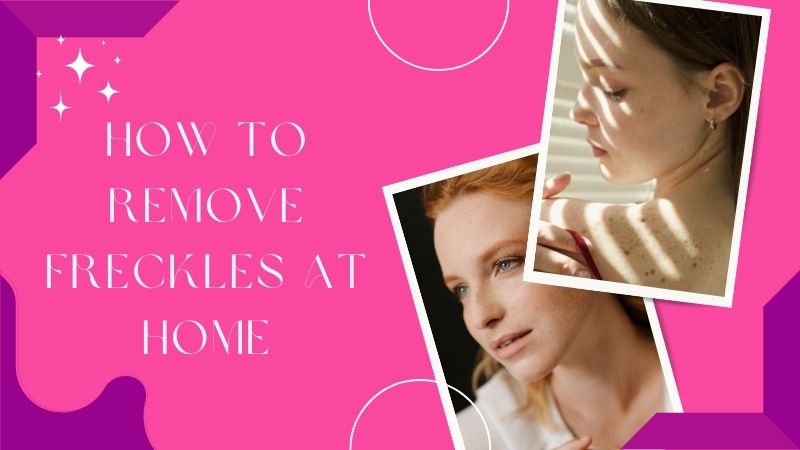
Freckles, those small, often pigmented spots on the skin, can evoke a range of emotions, from acceptance to concern. Understanding the psychological impact and promoting a positive perspective on freckles is crucial for self-esteem and overall well-being. This section delves into the multifaceted nature of freckles, exploring the varied ways individuals view and interact with them.
Freckles, though often considered a cosmetic concern, are a natural part of human skin variation. Their presence is largely determined by genetics and sun exposure. The psychological response to freckles, however, is highly personal and influenced by societal beauty standards and individual self-perception. Addressing these concerns involves promoting a broader understanding of beauty and embracing natural diversity.
Psychological Impact of Freckles
Concerns about freckles’ appearance frequently arise from societal beauty ideals that often favor certain skin tones and textures. This can lead to feelings of inadequacy, low self-esteem, and even body image issues. Some individuals may experience anxiety or self-consciousness due to the perceived imperfections that freckles represent.
Different Perspectives on Freckles
Different cultures and individuals hold diverse perspectives on freckles. In some cultures, freckles are associated with beauty, health, or even a connection to nature. This positive association fosters a sense of acceptance and pride in one’s unique features. In contrast, other cultures might hold different viewpoints.
Embracing Natural Appearance
Embracing one’s natural appearance, including freckles, is a crucial step in fostering self-acceptance and self-esteem. It’s important to recognize that beauty comes in countless forms, and focusing on internal qualities and strengths can shift the focus away from perceived physical flaws. Promoting a positive body image is essential for overall well-being.
Seeking Professional Advice
If concerns about freckles are significant, seeking guidance from a dermatologist or other healthcare professional can be beneficial. They can provide personalized advice and treatment options tailored to individual needs and concerns. Professional support can help individuals navigate these issues effectively and find solutions that align with their goals.
Positive Portrayals of Individuals with Freckles
A positive portrayal of individuals with freckles in media and art can significantly influence societal perceptions. This section highlights instances where individuals with freckles are showcased in a favorable light, fostering a sense of inclusivity and normalizing natural beauty.
| Media/Art | Description | Impact |
|---|---|---|
| Historical Portraits | Many historical portraits depict individuals with a range of skin tones and features, including freckles. These portrayals often showcase natural beauty, highlighting the diversity of human appearance. | Demonstrates historical acceptance of freckles. |
| Contemporary Fashion | Increasingly, fashion models and celebrities with freckles are featured in mainstream media, normalizing the presence of freckles. | Promotes inclusivity and diverse representation. |
| Literature/Film | Characters with freckles are often portrayed as relatable, complex, and beautiful, challenging societal norms around beauty. | Demonstrates that freckles are associated with positive character traits. |
| Art | Artists often portray individuals with freckles in a manner that celebrates their unique beauty, showcasing their natural charm. | Elevates freckles as an artistic element, highlighting their aesthetic value. |
Illustrations of Freckles
![How to Remove Freckles Naturally [10 Natural and Easy Ways] 2023 How to Remove Freckles Naturally [10 Natural and Easy Ways] 2023](https://tabatabol.site/wp-content/uploads/2025/06/How-to-remove-freckles-naturally.png)
Freckles, those small, often pigmented spots, can vary significantly in appearance. Their characteristics, from shape and size to distribution and the way they react to light, offer a fascinating insight into their nature. Understanding these visual variations is key to recognizing and managing freckles effectively.
Visualizing freckles, particularly in relation to their appearance under different lighting conditions, can be crucial for both self-assessment and professional evaluation. This section will detail various aspects of freckles’ appearance, allowing for a comprehensive understanding of their visual diversity.
Shape and Size Variations
Freckles typically appear as small, flat spots, ranging in shape from round to irregular. Their size is generally uniform across a given individual’s pattern, although variation can exist. Some freckles are nearly microscopic, while others can be noticeably larger. The distribution of freckles on the skin can also influence the overall appearance. For instance, some individuals have freckles concentrated in clusters, while others have them scattered more uniformly across exposed skin areas.
Distribution Patterns
The distribution of freckles on the skin can vary greatly. Some individuals have freckles concentrated in certain areas, such as the cheeks, nose, or shoulders, while others have them scattered more evenly across their face and upper body. Genetics plays a significant role in determining the overall distribution pattern.
Effects of Lighting Conditions
Different lighting conditions can significantly alter the appearance of freckles. Natural sunlight, often with a warmer tone, can highlight freckles more prominently than indoor lighting. Stronger sunlight tends to accentuate the contrast between the freckle and the surrounding skin, while softer lighting can diminish their visibility. Fluorescent lighting, for example, can sometimes cast a bluish hue, which might cause the freckles to appear less defined or even less noticeable. The angle of the light also plays a role; light directly overhead may cast the freckles into sharper relief than light from the side.
Visual Representation of Freckles
Various filters and techniques can be used to enhance or alter the visual representation of freckles. Photography, for example, can capture the nuances of freckles under different lighting conditions. Digital editing tools can be used to highlight or diminish freckles, altering their appearance. The use of filters and post-processing can create varied visual representations, which can be beneficial in various contexts, such as for educational purposes or personal reflection.
Illustrations of Freckles on Different Skin Tones



These images represent examples of how freckles can appear on different skin tones. Note that the appearance of freckles can vary considerably within each skin tone group. The concentration, size, and shape of freckles are highly variable, demonstrating the diversity in human skin pigmentation.
Illustrations of Freckles on Different Body Parts



These images highlight the diverse ways freckles can be distributed across various parts of the body. The location and concentration of freckles can be influenced by factors like sun exposure, genetics, and skin type.
Answers to Common Questions
How to eliminate freckles – What are the most effective topical treatments for freckles?
Topical treatments like chemical peels, retinoids, and hydroquinone can help reduce the appearance of freckles. However, it’s essential to consult a dermatologist to determine the most suitable option for your skin type and concerns. Always follow the prescribed application instructions and be aware of potential side effects.
How can I prevent future freckles?
Preventing future freckles is primarily about consistent sun protection. Regular use of high SPF sunscreen, protective clothing, and seeking shade during peak sun hours are crucial. A healthy diet and sufficient hydration also contribute to overall skin health.
Are freckles harmful?
No, freckles themselves are not harmful. However, excessive sun exposure can increase the risk of skin damage, including premature aging and, in extreme cases, skin cancer. It’s crucial to prioritize sun protection to minimize these risks.
